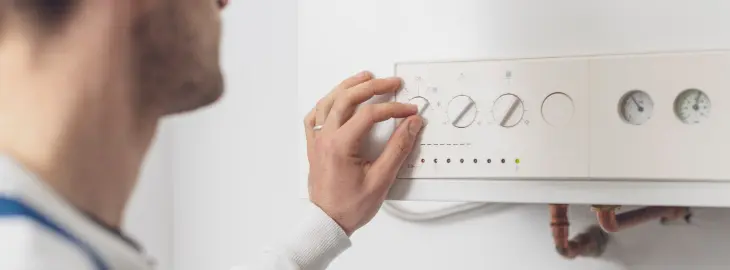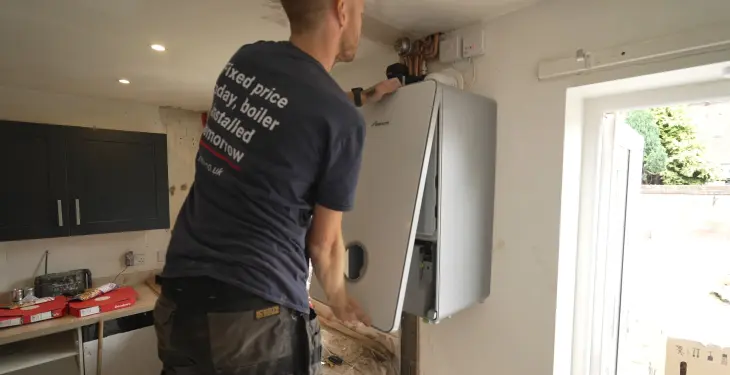

Written by Stephen Day
Gas Safe Engineer
Updated: 9th December, 2025
Most homes stay warm in winter with heating set at 60 to 70°C and hot water at 50 to 55°C.
Get a new boiler quote, save up to £550 per year (0% APR available).
Setting your boiler correctly in winter helps you stay warm, avoid wasted energy and reduce the strain on your system.
Many homeowners adjust their boiler based only on comfort, but understanding the basic controls makes a big difference.
This number controls how hot the water is when it leaves the boiler and travels to your radiators.
It affects how warm the radiators feel and how evenly they heat rooms.
This controls the temperature at your taps, bath and shower. If set too low, the water may feel lukewarm.
If set too high, you can waste energy and increase the risk of scalding.
The thermostat works with the boiler settings.
It measures the temperature in your home and tells the boiler when to turn on and off.
If it is placed in the wrong spot, it can give the wrong readings and make your home feel colder or hotter than it should.
Real example:
If your thermostat is in a cool hallway, it may keep the heating on longer than needed.
If it is next to a radiator, it may turn the heating off early.
Most homes are comfortable with a heating flow temperature of 60 to 70 degrees during the winter months.
This range provides strong radiator performance without wasting fuel.
They help your boiler run in its most efficient range.
They provide steady warmth rather than rapid bursts of heat.
They support even heat distribution around the home.
A modern flat with good insulation may stay warm at 60 degrees.
A semi detached home with moderate insulation often suits 65 degrees.
An older terraced property or a home with high heat loss may need closer to 70 degrees.
Large rooms with high ceilings may need a small increase to stay comfortable.
Hot water is best set between 50 and 55 degrees.
This range is warm enough for comfortable bathing, safe enough to reduce scald risk and efficient enough to avoid wasting energy.
Boiler type | Ideal winter heating setting | Ideal hot water setting |
|---|---|---|
Combi boiler | 60 to 70 degrees | 50 to 55 degrees |
System or heat only boiler | 65 to 70 degrees | Controlled by cylinder thermostat |
Underfloor heating | 30 to 45 degrees | Not applicable |
Homes with good insulation | Lower end of each range | 50 to 55 degrees |
Older or draughty homes | Higher end of each range | 50 to 55 degrees |
Combi boilers heat your radiators and hot water directly from the unit.
They react quickly to winter temperature changes, so settings often need small adjustments as the weather becomes colder.
Typical winter settings:
Heating: 60 to 70 degrees
Hot water: 50 to 55 degrees
These systems use a cylinder to store hot water.
They are common in larger homes where multiple bathrooms may be used at the same time.
Typical winter settings:
Heating: 65 to 70 degrees
Cylinder temperature is controlled separately by the cylinder thermostat.
Underfloor systems heat slowly and gently. They work best at lower temperatures because they cover a large surface area.
Typical winter settings:
Flow temperature: 30 to 45 degrees
Underfloor heating gives a steady, comfortable warmth all day, so it is normal for it to run at a lower temperature.
Flow temperature affects both comfort and efficiency.
Choosing the right setting helps your boiler work smoothly throughout the winter.
Radiators do not warm the home quicker just because the boiler is set high.The thermostat controls the heating cycles.
A higher flow temperature only increases the heat of the water, not the speed of heating.
When set correctly, a moderate flow temperature helps radiators deliver steady heat without forcing the boiler to burn more fuel.
Radiators only need to be warm enough to raise your room temperature.
Warm and steady heat is often more comfortable than short bursts of very hot water.
If your home feels cold even when the boiler temperature is correct, the issue may lie elsewhere in the system.
Here are the most common causes and simple checks you can make.

If radiators feel warm at the bottom but cold at the top, there is air trapped inside. Bleeding the radiator helps restore full heat.

Most boilers run best between 1 and 1.5 bar. Low pressure reduces heating efficiency and can stop radiators warming properly.

If the thermostat is in a cold hallway, near a draught, behind a door or close to a radiator, it may not read the room temperature correctly.

These valves control how much hot water flows through each radiator.
If one is turned down too low, it may affect how quickly a room heats up.

Poor insulation lets heat escape quickly, which makes your home harder to warm even with the correct boiler settings.
Simple steps such as closing internal doors, using curtains and sealing small gaps can make a noticeable difference.
A two bedroom flat with modern insulation will often heat comfortably at 60 degrees.
A family home with two bathrooms and several radiators running at once may need 65 to 70 degrees.
A home with north facing rooms may need a small temperature increase during cold spells.
A loft conversion with large radiators may warm faster with a flow temperature at the top of the range.
These examples help you judge your own home’s needs.
Some heating issues should not be fixed at home. Book an engineer if:
The heating does not reach the set temperature
Pressure drops again after you top it up
Radiators stay cold after bleeding
The boiler makes unusual noises
Hot water becomes unreliable
The heating switches on and off frequently
An engineer can help prevent breakdowns and keep your system safe through winter.
Most homes feel warm and comfortable with a heating flow temperature between 60 and 70 degrees and hot water set between 50 and 55 degrees.
The right combination, along with simple checks such as bleeding radiators and looking after insulation, can make a real difference to comfort and efficiency.
If your boiler struggles to heat your home or you are thinking about upgrading to a newer model, iHeat offers fast online quotes and expert installation from Gas Safe engineers across the UK.
Last updated: 9th December, 2025

Written by Stephen Day
Gas Safe Engineer at iHeat
Stephen Day is a Gas Safe registered and FGAS certified engineer with over 20 years of hands-on experience in the heating, cooling, and renewable energy industry, specialising in boiler installations, air conditioning, and heat pump systems.
LinkedInArticles by Stephen Day are reviewed by iHeat’s technical team to ensure accuracy and reliability.

22nd December, 2025
Based on data from over 7000 boiler installations completed by iHeat in the past 12 months...
 Read Article
Read Article

22nd December, 2025
Here’s a quick roundup of the best combi boilers for 2026.
 Read Article
Read Article

22nd December, 2025
When your old boiler breaks down and it comes time to replace it with a new one, it might...
 Read Article
Read Article
No obligation. Takes less than 60 seconds.